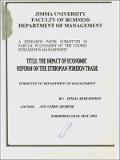| dc.description.abstract | Ethiopia has been perusing a passive exchange rate policy having the "Birr" pegged to US
dollar which is believed to have imposed an adverse impact on economic efficiency and growth,
especially which makes production for export unprofitable while imports become artificially cheaper
resulting in increased smuggling of exportable goods. So, an over valued exchange rate would lead
to persistent trade deficit since it makes earnings from export to decline. In addition, as the country
was following command economic system, the micro economic management of Ethiopia was poor. In
general policy problems, I markets structural constraints »and natural factors have been the major
problems to Ethiopian foreign trade. Due to these, the current account of the balance of payment
has been widening form time to time.
However, after the fall of the derg military regime, a package of policy measures have been
undertaken with the objective of encouraging exports, while discouraging imports and there by
improve the external performance of the country. Among these, trade liberalization, cur!ency
devaluation and reduction in export duty can be-mentioned»
This study is aimed at the assessment of the progress in external performance of the country
as attributed to the reform program. The data needed (secondary data) was collected from ministry
of trade and industry, central statistics bureau, Customs Authority and National Bank of Ethiopia all
located in Addis Ababa. The data was analyzed quantitatively and descriptively; and interpreted on
comparative basis and the report includes multiples of tables and chart showing yearly improvement
in external performance of the country. Comparison is also made between average terms of trade
(ratio of export to import) over a decade, before and after the reform. Emphasis has been also given
to the degree of improvement in export and import ratio to GDP of the country.
The major recommendation is that the country should diversify its product and market and
seek ways to improve quality of the existing products. | en |


